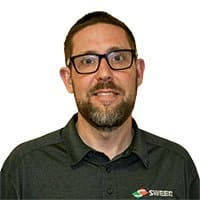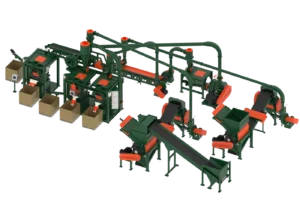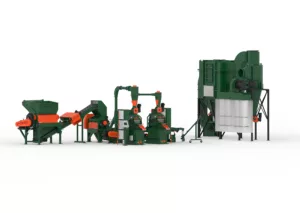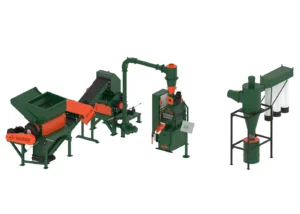ASK THE EXPERT: 5 questions about maximizing wire chopping line performance
As seen in Recycling Today magazine
Christopher Simon, recycling system sales representative at SWEED Machinery, shares tips on how to maximize the performance of a wire chopping line.
1. How can recyclers ensure maximum recovery of copper from lower-grade insulated wire scrap?

Maximizing copper recovery starts with a system designed to handle the unique challenges of your material profile. Lower-grade wire and other complex materials can be efficiently processed with the right approach, but avoiding overworking them is key. Overprocessing increases operating costs and generates copper dust that is lost during collection, lowering overall recovery rates.
SWEED systems optimize material flow by incorporating bypass capabilities, so materials are only processed as needed. This ensures each material type receives the appropriate level of processing and clean copper is recovered in a single pass. By reducing redundant steps, SWEED systems preserve more copper, lower operational costs and provide flexibility to adapt to market trends or material profiles
2. How does SWEED approach data capture or production feedback?
SWEED sets the standard for data capture and system monitoring through our advanced HMI (human machine interface). With sensors and integrated scale systems, operators gain real-time insights into system capacity and efficiency. Automated detailed reports on machine condition, loading and uptime help stakeholders understand costs tied to material categories, providing data to guide purchasing and improve profitability.
Our system also alerts operators to potential issues. For instance, you can set alarms to trigger if copper recovery drops below a certain threshold, signaling a mechanical issue or lower-than-expected material quality, allowing operators to respond quickly.
3. What steps can recyclers take to future-proof their wire chopping investments?
Our radiator lines achieve throughput exceeding 20,000 pounds per hour while maintaining high-purity copper and aluminum recovery.
SWEED’s Reda Cable systems handle complex materials with precision, efficiently removing armor and lead to expose conductors for further processing. These systems integrate seamlessly into chopping lines, enhancing efficiency and flexibility.
The redesigned SG1840 granulator features a rigid frame for reduced vibration, an optimized rotor for precision cutting and ergonomic upgrades for easier maintenance and knife adjustments.
4. What innovations has SWEED introduced to enhance the performance and reliability of its copper and aluminum recovery equipment?
The cost to run and maintain a chopping line will fall between 1.5 cents and 3 cents per pound, including labor, spare parts and downtime. However, maintenance and operating costs for a chopping line will vary depending on several factors. The overall size and scope of the operation will dictate its operating and maintenance costs. For example, a system processing low-yield ICW at 1,500 pounds per hour will differ from a large-scale system processing the same material at 6,000 pounds per hour. As previously noted, it costs more per pound to run less scrap volume than a large volume system.
Another factor affecting operating and maintenance costs is operating the right equipment for the job. There is nuance for spreading material burden throughout a system and efficiently processing with high-purity recovery. SWEED specializes in custom systems and focuses on designing to the customer’s need, with contingencies.
5. What can I expect working with SWEED?
Our sales process typically begins with an on-site visit and consultation to fully understand the customer’s material profile and operational goals. Using this information, we design a custom system tailored to its unique operation. To give customers confidence in their investment, we offer material testing at our Test Center.
After commissioning, our team works closely with customers to optimize operations and maximize ROI.
With SWEED, customers are not just purchasing equipment but also partnering with a team committed to their long-term success.




